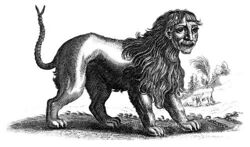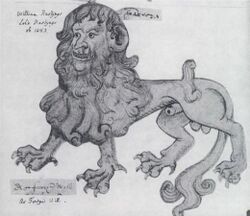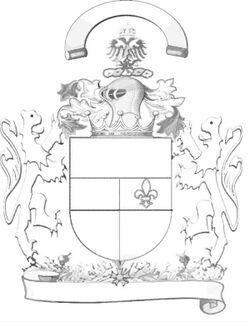Biology:Manticore
Manticore (1678) | |
| Grouping | Legendary creatures |
|---|---|
| Sub grouping | Mythological hybrids |
The manticore (Early Middle Persian Merthykhuwar) modern persian ("Mardykhor") is a Persian legendary creature similar to the Egyptian sphinx that proliferated in western European medieval art as well. It has the head of a human, body of a lion and a tail of venomous spines similar to porcupine quills, while other depictions have it with the tail of a scorpion. There are some accounts that the spines can be shot like arrows, thus making the manticore a lethal predator. It eats its victims whole, using its triple rows of teeth, and leaves no bones behind.
The mantyger is a creature of medieval invention, having the body of a heraldic tiger with mane, and the head of an old man, the tusks of a boar and with long spiral horns.[citation needed] Some heraldic authorities make the horns more like those of an ox, and the hands and feet like a monkey's.
Origin
The Manticore myth was of Persian origin, where its name was "man-eater" (from early Middle Persian مارتیا mardya "man" (as in human) and خوار khowr- "to eat"). The English term "manticore" was borrowed from Latin mantichora, itself derived from the Greek rendering of the Persian name, μαρτιχώρα, martichora. It passed into European folklore first through a remark by Ctesias, a Greek physician at the Persian court of King Artaxerxes II in the fourth century BC, in his book Indica ("India"), which circulated among Greek writers on natural history but has survived only in fragments, or references by those other writers. The Romanised Greek Pausanias, in his Description of Greece, recalled strange animals he had seen at Rome and commented,
The beast described by Ctesias in his Indian history, which he says is called martichoras by the Indians and "man-eater" [androphagos] by the Greeks, I am inclined to think is the tiger. But that it has three rows of teeth along each jaw and spikes at the tip of its tail with which it defends itself at close quarters, while it hurls them like an archer's arrows at more distant enemies; all this is, I think, a false story that the Indians pass on from one to another owing to their excessive dread of the beast. (Description, 9.21.4)
Pliny the Elder did not share Pausanias' skepticism. He followed Aristotle's natural history by including the martichoras – mistranscribed as manticorus in his copy of Aristotle – among his descriptions of animals in Naturalis Historia 8:30, c. 77 AD.
Later, in The Life of Apollonius of Tyana Greek writer Flavius Philostratus (c. 170–247) wrote:
And inasmuch as the following conversation also has been recorded by Damis as having been held upon this occasion with regard to the mythological animals and fountains and men met with in India, I must not leave it out, for there is much to be gained by neither believing nor yet disbelieving everything. Accordingly Apollonius asked the question, whether there was there an animal called the man-eater (martichoras); and Iarchas replied: "And what have you heard about the make of this animal? For it is probable that there is some account given of its shape." "There are," replied Apollonius, "tall stories current which I cannot believe; for they say that the creature has four feet, and that his head resembles that of a man, but that in size it is comparable to a lion; while the tail of this animal puts out hairs a cubit long and sharp as thorns, which it shoots like arrows at those who hunt it."[1]
Medieval and post-medieval appearances
Pliny's book was widely enjoyed and uncritically believed through the European Middle Ages, during which the manticore was sometimes described or illustrated in bestiaries. Through false etymology, it was sometimes assumed that the name was an amalgamation of man and tiger;[2] although other sources regarded the mantyger as a different creature entirely (the mantyger having monkey-like feet, being apparently inspired by the baboon; and also sometimes being represented with either tusks or short horns).[3] There was further confusion as to whether the manticore should be identified with or distinguished from the satyral and the lampago.[4]
Dante Alighieri, in his Inferno, depicted the mythical creature Geryon as a manticore, following Pliny's description.[5]
The manticore or mantyger first appeared in English heraldry in c.1470, as a badge of William Hastings, 1st Baron Hastings; and in the 16th century it was used as a badge by Robert Radcliffe, 1st Earl of Sussex, and by Sir Anthony Babyngton.[6] Randle Holme in 1688 described the manticore (which he regarded as distinct from the mantyger) as having
- the face of a man, the mouth open to the ears with a treble row of teeth beneath and above; long neck, whose greatness, roughness, body and feet are like a Lyon: of a red colour, his tail like the tail of a Scorpion of the Earth, the end armed with a sting, casting forth sharp pointed quills.[7]
The heraldic manticore influenced some Mannerist representations of the sin of Fraud, conceived as a monstrous chimera with a beautiful woman's face – for example, in Bronzino's allegory, "Venus, Cupid, Folly and Time" (National Gallery, London),[8] and more commonly in the decorative schemes called "grotteschi". From here it passed by way of Cesare Ripa's Iconologia into the seventeenth- and eighteenth-century French conception of a sphinx.
Gerald Brenan linked the manticore to the mantequero, a monster feeding on human fat in Andalusian folklore.[9]
In popular culture
See also
- Lampago, a "man tiger"
References
- ↑ Flavius Philostratus, The Life of Apollonius of Tyana, translated by F. C. Conybeare, volume I, book III. Chapter XLV, pp. 327–329.
- ↑ manticore (3rd ed.), Oxford University Press, September 2005, http://oed.com/search?searchType=dictionary&q=manticore (Subscription or UK public library membership required.)
- ↑ Dennys 1975, pp. 114–7
- ↑ Dennys 1975, p. 114.
- ↑ Dante Alighieri; Grandgent, C. H (1933) (in Italian). La Divina commedia di Dante Alighieri,. Boston; New York: D.C. Heath and Co.. https://www.worldcat.org/title/divina-commedia-di-dante-alighieri/oclc/1026178. "Dante's image was profoundly modified, however, by Pliny's description---followed by Solinus---of a strange beast called Mantichora (Historia Naturalis, VIII, 30) which has the face of a man, the body of a lion, and a tail ending in a sting like a scorpion's"
- ↑ Dennys 1975, pp. 115–6.
- ↑ Holme, Randle (1688). The Academy of Armorie and Blazon. Chester. p. 212.; quoted in Dennys 1975, p. 115.
- ↑ Moffitt, John F. (1996). "An Exemplary Humanist Hybrid: Vasari's "Fraude" with Reference to Bronzino's "Sphinx"". Renaissance Quarterly 49 (2): 303–333. doi:10.2307/2863160. traces the chimeric image of Fraud backwards from Bronzino.
- ↑ Al Sur de Granada, pages 190-193, Gerald Brenan, 1997, Fábula - Tusquets Editores. Originally South from Granada, 1957
Further reading
- Dennys, Rodney (1975). The Heraldic Imagination. London: Barrie & Jenkins. pp. 114–7.
External links





